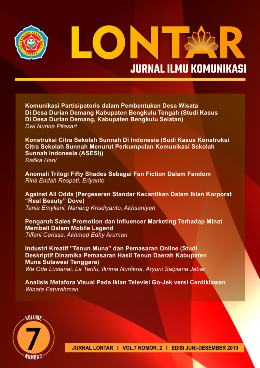Konstruksi Citra Sekolah Sunnah di Indonesia (Studi Kasus Konstruksi Citra Sekolah Sunnah Menurut Perkumpulan Komunikasi Sekolah Sunnah Indonesia (ASESI)
DOI:
https://doi.org/10.30656/lontar.v7i2.2042Keywords:
image construction, construction of reality, sunnah school, educationAbstract
Nowadays, there are so many emerging Islamic schools in Indonesia. One of them is theestablishment Islamic school which is the Islamic religious education based on Al-Qurán and AsSunnah Shahih from Rasululullah Shallallahuálaihiwasallam. This school are known as the Sunnah
School or school in Manhaj Ahlusunnah waljamaáh, and more often also called as Salafi school.
ASESI as a communication forum for sunnah schools in Indonesia see the realities of the phenomenon
of sunnah schools in Indonesia. This study uses a qualitative descriptive method with a case study
approach. Data collection techniques are carried out by observation, interviews, and literature.
ASESI process the image construction of sunnah schools in Indonesia. The process consists of
externalization by looking at the realities that the management of the Sunnah school in Indonesia is
still not well organized. The objectivation process is that ASESI organizes programs to improve the
image of the sunnah school as a school that has a quality sunnah. The internalization process, namely
ASESI, means the community's perception of the enthusiasm of the community towards the programs
carried out by ASESI.
Downloads
Published
Issue
Section
License
By submitting an article to the journal, the author(s) agree to transfer the published article's copyright to the journal, which will act as the publisher. This means the journal will have the right to publish the article in various forms, including reprints. The journal will maintain the publishing rights to the published articles.
In line with the license, authors and third parties (readers, researchers, and others) are allowed to share and adapt the material. In addition, the material must be given appropriate credit, provided with a link to the license, and indicated if changes were made. If authors remix, transform, or build upon the material, authors must distribute their contributions under the same license as the original.






